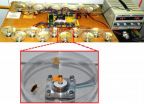(Press-News.org) Pinecone or pine nut? Friend or foe? Distinguishing between the two requires that we pay special attention to the telltale characteristics of each.
And as it turns out, us humans aren't the only ones up to the task.
According to researchers at the University of Iowa, pigeons share our ability to place everyday things in categories. And, like people, they can hone in on visual information that is new or important and dismiss what is not.
"The basic concept at play is selective attention. That is, in a complex world, with its booming, buzzing confusion, we don't attend to all properties of our environment. We attend to those that are novel or relevant," says Edward Wasserman, UI psychology professor and secondary author on the paper, published in the Journal of Experimental Psychology: Animal Learning and Cognition.
Selective attention has traditionally been viewed as unique to humans. But as UI research scientist and lead author of the study Leyre Castro explains, scientists now know that discerning one category from another is vital to survival.
"All animals in the wild need to distinguish what might be food from what might be poison, and, of course be able to single out predators from harmless creatures," she says.
More than that, other creatures seem to follow the same thought process humans do when it comes to making these distinctions. Castro and Wasserman's study reveals that learning about an object's relevant characteristics and using those characteristics to categorize it go hand-in-hand.
When observing pigeons, "We thought they would learn what was relevant (step one) and then learn the appropriate response (step two)," Wasserman explains. But instead, the researchers found that learning and categorization seemed to occur simultaneously in the brain.
To test how, and indeed whether, animals like pigeons use selective attention, Wasserman and Castro presented the birds with a touchscreen containing two sets of four computer-generated images—such as stars, spirals, and bubbles.
The pigeons had to determine what distinguished one set from the other. For example, did one set contain a star while the other contained bubbles?
By monitoring what images the pigeons pecked on the touchscreen, Wasserman and Castro were able to determine what the birds were looking at. Were they pecking at the relevant, distinguishing characteristics of each set—in this case the stars and the bubbles?
The answer was yes, suggesting that pigeons—like humans—use selective attention to place objects in appropriate categories. And according to the researchers, the finding can be extended to other animals like lizards and goldfish.
"Because a pigeon's beak is midway between its eyes, we have a pretty good idea that where it is looking is where it is pecking," Wasserman says. This could be true of any bird or fish or reptile.
"However, we can't assume our findings would hold true in an animal with appendages—such as arms—because their eyes can look somewhere other than where their hand or paw is touching," he explains.
INFORMATION:
The study, "Pigeons' Tracking of Relevant Attributes in Categorization Learning," was published in the April 2 print edition of the Journal of Experimental Psychology: Animal Learning and Cognition. Funding was provided by the UI psychology department.
Great minds think alike
Study finds pigeons and other animals can place everyday things in categories like humans
2014-04-02
ELSE PRESS RELEASES FROM THIS DATE:
'Touched' female cockroaches reproduce faster
2014-04-02
To speed up reproduction, there's no substitute for the tender touch of a live cockroach.
That's the major takeaway from a North Carolina State University study examining whether artificial antennae – in this case, duck feathers – can mimic a cockroach antenna's capacity to hasten reproduction in cockroach females.
Female cockroaches that get "touched" – by other female cockroaches and, under certain conditions, even by duck feathers that mimic roach antennae – reproduce faster than female roaches that live in isolation or without tactile stimulation.
...
Ancient nomads spread earliest domestic grains along Silk Road, study finds
2014-04-02
Charred grains of barley, millet and wheat deposited nearly 5,000 years ago at campsites in the high plains of Kazakhstan show that nomadic sheepherders played a surprisingly important role in the early spread of domesticated crops throughout a mountainous east-west corridor along the historic Silk Road, suggests new research from Washington University in St. Louis.
"Our findings indicate that ancient nomadic pastoralists were key players in an east-west network that linked innovations and commodities between present-day China and southwest Asia," said study co-author ...
Unvaccinated infants act as 'kindling' to fuel epidemics
2014-04-02
ANN ARBOR—Nearly 4 million children under 5 die from vaccine-preventable diseases worldwide each year, and two University of Michigan doctoral ecology students are working to change that.
By taking into account seasonal fluctuations in birth rates, massive vaccination campaigns in the developing world could inoculate more unprotected infants and significantly reduce the number of deaths from diseases like measles, according to Micaela Martinez-Bakker and Kevin Bakker of the U-M Department of Ecology and Evolutionary Biology.
"If you have lots of kindling, you can have ...
Care of heart failure patients falling short in the UK
2014-04-02
Care of patients with heart failure in the UK is inadequate and has not changed in a decade, according to new research published in BMJ Open.
The findings by a team at Durham University and Darlington Memorial Hospital - and funded by national charity Heart Research UK - highlight inadequacies in heart failure care as well as an uncoordinated approach to diagnosis and management of the condition between primary and secondary care clinicians.
The research showed that clinicians are uncertain about how to diagnose different types of heart failure and about who has overall ...
Warm North Atlantic Ocean promotes extreme winters in US and Europe
2014-04-02
The extreme cold weather observed across Europe and the east coast of the US in recent winters could be partly down to natural, long-term variations in sea surface temperatures, according to a new study published today.
Researchers from the University of California Irvine have shown that a phenomenon known as the Atlantic Multidecadal Oscillation (AMO)—a natural pattern of variation in North Atlantic sea surface temperatures that switches between a positive and negative phase every 60-70 years—can affect an atmospheric circulation pattern, known as the North Atlantic ...
Not so dirty: Methane fuels life in pristine chalk rivers
2014-04-02
Scientists from Queen Mary University of London have found that naturally high concentrations of the greenhouse gas methane contributes to energy production in chalk rivers, in a new study published today in the journal Proceedings of the Royal Society B.
Chalk rivers, found from Dorset to Cambridgeshire, sustain a diverse range of protected animals and plants, and are renowned globally for fly fishing, an industry worth more than £4M on the Rivers Test and Itchen (Hampshire) alone.
"It's a surprise to find methane is such a big source of energy in these gin-clear ...
Male extinction prevented by promiscuous females
2014-04-02
LIVERPOOL, UK – 2 April 2014: Female fruit flies with a large number of sexual partners are playing an invaluable role in preventing the extinction of males, research at the University of Liverpool has shown.
Scientists have found that flies in the northern parts of the United States are more inclined to have multiple partners in order to reduce the occurrence of an X chromosome which causes the production of only female offspring.
This selfish genetic element (SGE) tries to replicate itself by killing sperm that carry the Y chromosome, but has the side-effect that ...
Still no clear evidence for health benefits of vitamin D
2014-04-02
They argue that "universal conclusions about its benefits cannot be drawn" and say further studies and better designed trials are needed.
A growing body of evidence indicates that vitamin D may reduce risks of a wide range of diseases, including bone mineral disease, multiple sclerosis, autoimmune disorders, cancer and cardiovascular problems. Yet, despite hundreds of trials, the evidence for vitamin D is still being debated.
Two papers published on bmj.com today attempt to make sense of the existing data.
The first, by researchers based in the UK, Europe and USA, ...
Probiotics do not help infants with colic
2014-04-02
These findings differ from previous smaller trials and do not support a general recommendation for the use of probiotics to treat colic in infants.
Infant colic (excessive crying of unknown cause) affects up to 20% of infants and is a major burden to families and health services. Although it spontaneously resolves three to four months after birth, its cause remains elusive and no single effective treatment exists.
Previous small trials suggest that the probiotic Lactobacillus reuteri effectively treats colic in breastfed infants. These studies, however, had limitations ...
New dementia diagnosis targets will lead to overdiagnosis
2014-04-02
The government is putting pressure on commissioners, and in turn general practitioners, to make more diagnoses of dementia, but no analysis has been done to assess the harm that these targets could cause.
Dr Martin Brunet, a GP from Surrey, says that "medicine depends on a fundamental, unspoken agreement between patients and doctors […] the only factor influencing the decision to diagnose should be the best interests of patients". He adds that the idea of doctors being motivated by self interest is "abhorrent and undermines the basis of the relationship".
He says that ...
LAST 30 PRESS RELEASES:
First Editorial of 2026: Resisting AI slop
Joint ground- and space-based observations reveal Saturn-mass rogue planet
Inheritable genetic variant offers protection against blood cancer risk and progression
Pigs settled Pacific islands alongside early human voyagers
A Coral reef’s daily pulse reshapes microbes in surrounding waters
EAST Tokamak experiments exceed plasma density limit, offering new approach to fusion ignition
Groundbreaking discovery reveals Africa’s oldest cremation pyre and complex ritual practices
First breathing ‘lung-on-chip’ developed using genetically identical cells
How people moved pigs across the Pacific
Interaction of climate change and human activity and its impact on plant diversity in Qinghai-Tibet plateau
From addressing uncertainty to national strategy: an interpretation of Professor Lim Siong Guan’s views
Clinical trials on AI language model use in digestive healthcare
Scientists improve robotic visual–inertial trajectory localization accuracy using cross-modal interaction and selection techniques
Correlation between cancer cachexia and immune-related adverse events in HCC
Human adipose tissue: a new source for functional organoids
Metro lines double as freight highways during off-peak hours, Beijing study shows
Biomedical functions and applications of nanomaterials in tumor diagnosis and treatment: perspectives from ophthalmic oncology
3D imaging unveils how passivation improves perovskite solar cell performance
Enriching framework Al sites in 8-membered rings of Cu-SSZ-39 zeolite to enhance low-temperature ammonia selective catalytic reduction performance
AI-powered RNA drug development: a new frontier in therapeutics
Decoupling the HOR enhancement on PtRu: Dynamically matching interfacial water to reaction coordinates
Sulfur isn’t poisonous when it synergistically acts with phosphine in olefins hydroformylation
URI researchers uncover molecular mechanisms behind speciation in corals
Chitin based carbon aerogel offers a cleaner way to store thermal energy
Tracing hidden sources of nitrate pollution in rapidly changing rural urban landscapes
Viruses on plastic pollution may quietly accelerate the spread of antibiotic resistance
Three UH Rainbow Babies & Children’s faculty elected to prestigious American Pediatric Society
Tunnel resilience models unveiled to aid post-earthquake recovery
Satellite communication systems: the future of 5G/6G connectivity
Space computing power networks: a new frontier for satellite technologies
[Press-News.org] Great minds think alikeStudy finds pigeons and other animals can place everyday things in categories like humans


